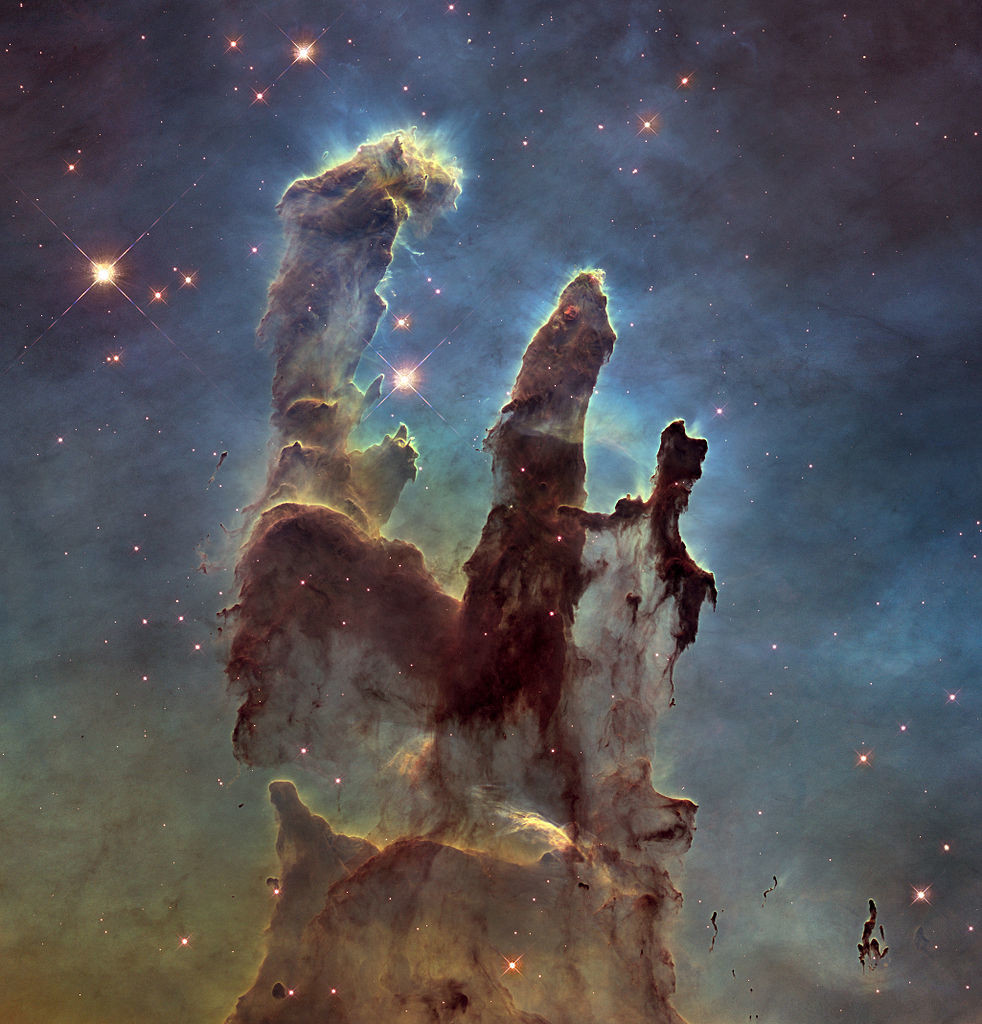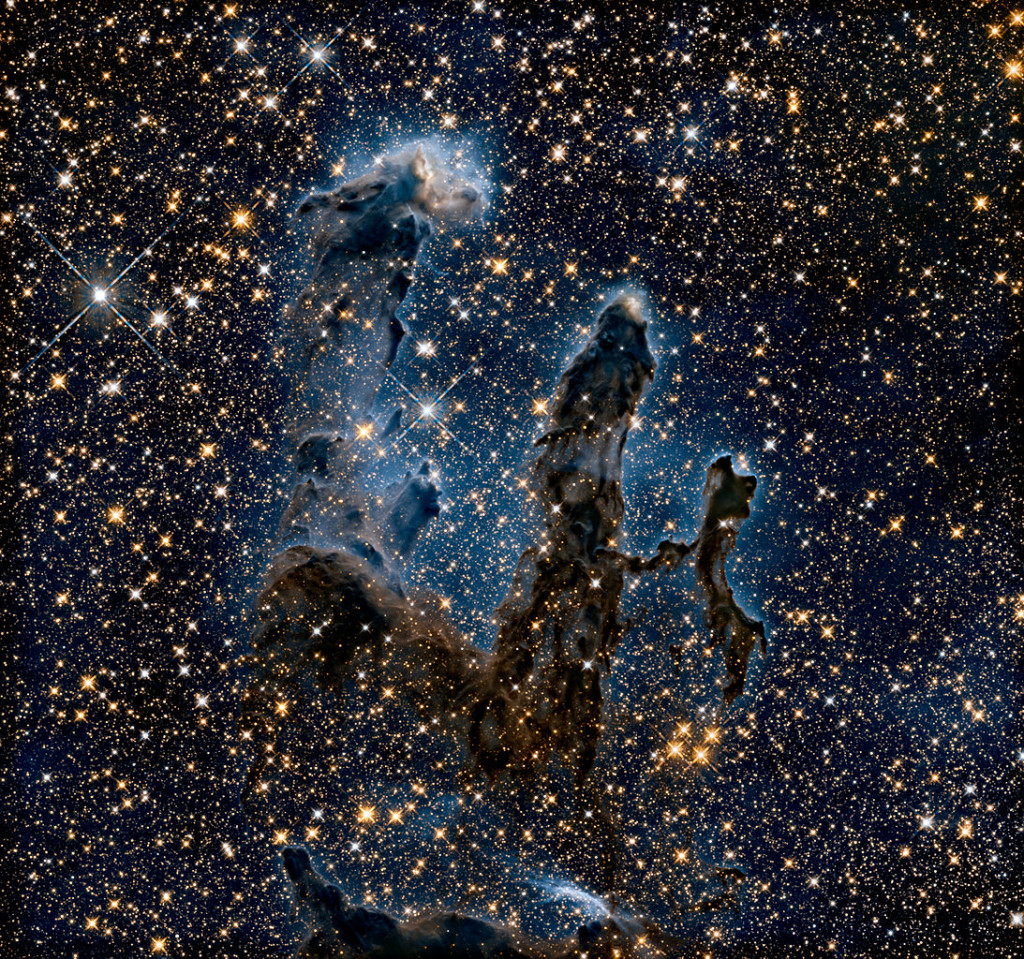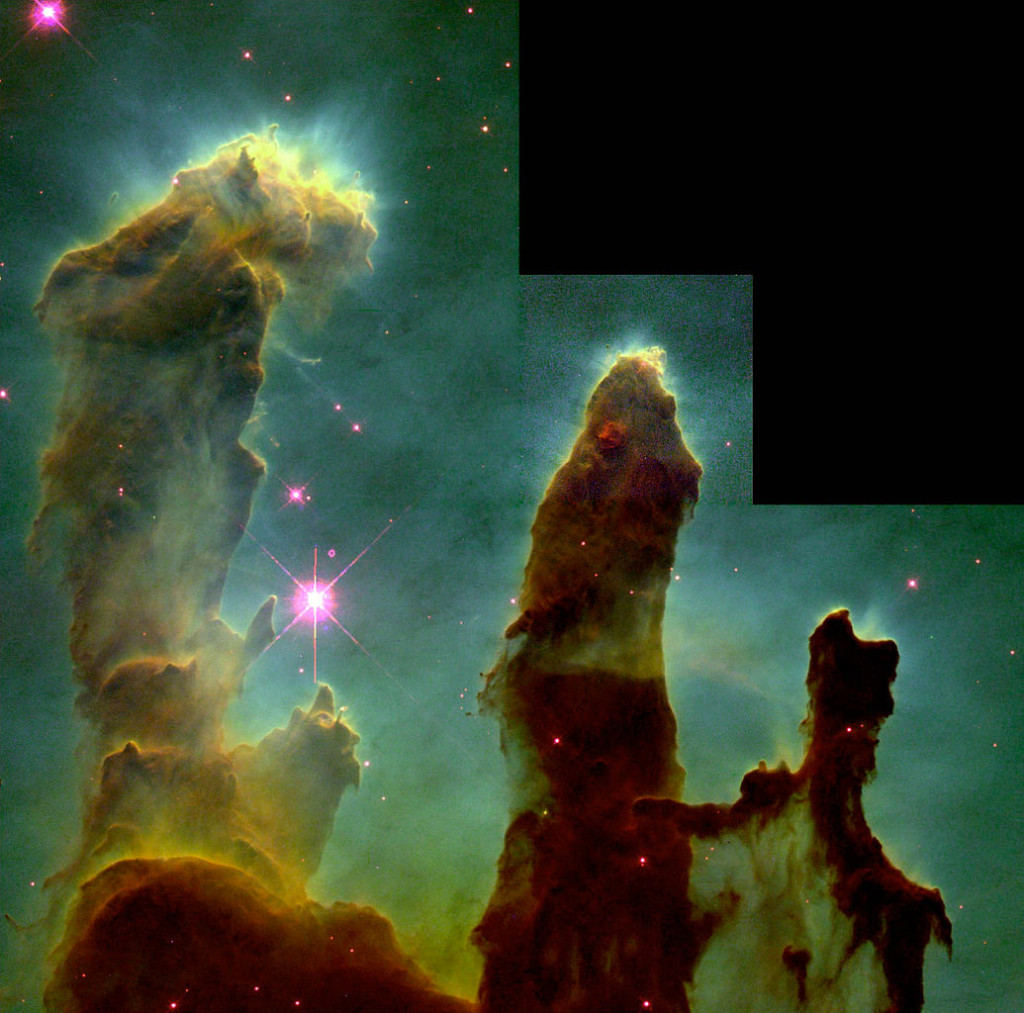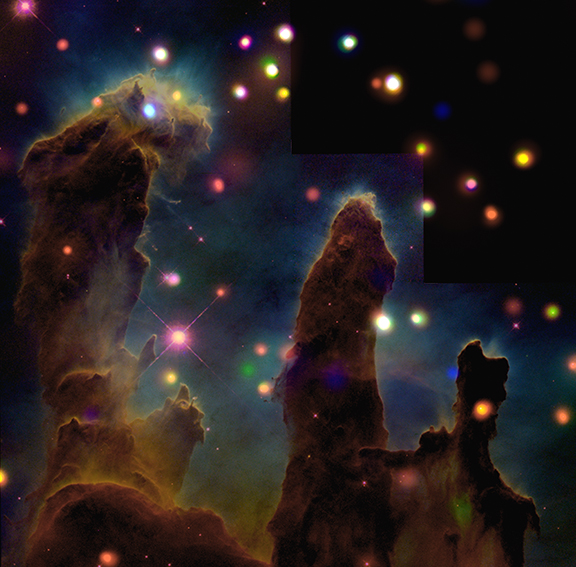The Pillars of Creation are famous pillars of gas and dust found in one of the several star-forming regions of the Eagle Nebula, Messier 16. The region was named after a photograph taken by the Hubble Space Telescope on April 1, 1995.
The stars formed in this region have surface temperatures exceeding 30,000 degrees Celsius while they are on the main sequence. In comparison, the Sun’s temperature is only about 5,500 degrees. The young stars in M16 are a source of strong stellar wind and intense ultraviolet light that shapes and gradually erodes the gas and dust structures in the region.
The Hubble image by Jeff Hester and Paul Scowen, astronomers at Arizona State University at the time, was so named because the pillars of gas were in the process of creating new stars. At the same time, the pillars were also being destroyed by the intense ultraviolet radiation from the nearby newly formed stars.

The pillars are bathed in the blistering ultraviolet light from a grouping of young, massive stars located off the top of the image. Streamers of gas can be seen bleeding off the pillars as the intense radiation heats and evaporates it into space. Denser regions of the pillars are shadowing material beneath them from the powerful radiation. Stars are being born deep inside the pillars, which are made of cold hydrogen gas laced with dust. The pillars are part of a small region of the Eagle Nebula, a vast star-forming region 6,500 light-years from Earth. The colors in the image highlight emission from several chemical elements. Oxygen emission is blue, sulfur is orange, and hydrogen and nitrogen are green. A number of Herbig-Haro jets lengthened noticeably in the 20-year interval between the two Hubble images. Image: NASA, ESA, and the Hubble Heritage Team (STScI/AURA), January 2015
The Pillars of Creation are composed of dust and cool molecular hydrogen. The tallest pillar, to the left of the image, is roughly 4 light years high, while the protrusions seen at the top of the clouds that form the pillars are larger in size than the entire solar system.
The gas behind the protrusions is shielded from the ultraviolet radiation of the young stars by evaporating gaseous globules (EGGs), regions of hydrogen gas that were first conclusively identified in Hubble images in 1995. The gas and dust inside the EGGs are denser than those outside and eventually begin to form protostars, making EGGs incubators of new stars.

A near-infrared survey using the Very Large Telescope’s (VLT) 8.2m-diameter ANTU telescope and the ISAAC (Infrared Spectrometry and Array Camera) instrument has revealed that 11 of the 73 EGGs possibly contained young, low-mass stars and that the tips of the three pillars also had young stars and nebulosity not revealed by the Hubble image.
The Pillars of Creation were likely destroyed in a supernova explosion some 6,000 years ago. Photographs taken with the Spitzer Space Telescope have revealed a cloud of hot dust near the pillars that could have been a shock wave created by the supernova, and if this were the case, the pillars would have been directly in the shock wave’s path.
As the pillars are located at a distance of 7,000 light years from Earth, the destruction – if it had indeed occurred – will not be visible from Earth for another 1,000 years. However, there are scientists who believe that the supernova event may not have occurred at all, as the radio and X-ray radiation should have been more intense than those observed. Without the supernova event, the pillars will be eroded more gradually, over a longer period of time.

The picture was taken on April 1, 1995 with the Hubble Space Telescope Wide Field and Planetary Camera 2. The color image is constructed from three separate images taken in the light of emission from different types of atoms. Red shows emission from singly-ionized sulfur atoms. Green shows emission from hydrogen. Blue shows light emitted by doubly- ionized oxygen atoms. Image: NASA, Jeff Hester and Paul Scowen, Arizona State University
The Herschel Space Observatory photographed the Pillars of Creation in far-infrared wavelengths in 2011. The image provided astronomers with a better insight into the structures, processes and forces at play inside the region of the Eagle Nebula.
The X-ray images of the Pillars of Creation from the Chandra X-ray Observatory have revealed that any newly formed stars embedded with the EGGs are not hot enough yet to emit X-rays as all X-ray sources were found randomly scattered around the area, not coinciding with the pillars.

The Chandra observations did not detect X-rays from any of the so-called evaporating gaseous globules, or EGGs. The EGGs are dense, compact pockets of interstellar gas where stars are believed to be forming. The lack of X-rays from these objects may mean that most of the EGGs do not contain enshrouded stars. However, infrared observations have shown that 11 of the 73 EGGs contain infant stellar objects and 4 of these are massive enough to form a star. The stars embedded in these 4 EGGs might be so young that they have not generated X-rays yet and one of them (E42) – estimated to have about the mass of the Sun – could represent one of the earliest stages of evolution of our nearest star. The Sun was likely born in a region like the Pillars of Creation. The pillars and the few stars forming inside them are the last vestiges of star formation in the Eagle Nebula, also known as M16, which peaked several million years earlier. This contrasts strongly with the active star forming regions in other clusters such as NGC 2024, where Chandra sees a dense cluster of embedded young stars.
The results were published in the January 1st issue of The Astrophysical Journal and the research team, led by Jeffrey Linsky of the University of Colorado, includes Marc Gagne and Anna Mytyk (West Chester University), Mark McCaughrean (University of Exeter) and Morten Andersen (University of Arizona). Image – X-ray: NASA/CXC/U.Colorado/Linsky et al.; Optical: NASA/ESA/STScI/ASU/J.Hester & P.Scowen.
A new image of the pillars, taken by Hubble, was unveiled at the American Astronomical Society meeting in Seattle in January 2015 in celebration of Hubble’s 25th anniversary on April 24, 2015. The pillars were photographed with Hubble’s Wide Field Camera 3 and the image was created using visible light and near-infrared exposure.
The pillar structure in the Eagle Nebula is similar to the one found in the much larger Soul Nebula (Westerhout 5, IC 1848), a star-forming region located in the constellation Cassiopeia, which was photographed by Spitzer in 2005. The gas pillars in the Soul Nebula, which also resemble stalagmites sticking out from the floor of a cavern, are known as the “Pillars of Star Creation.”